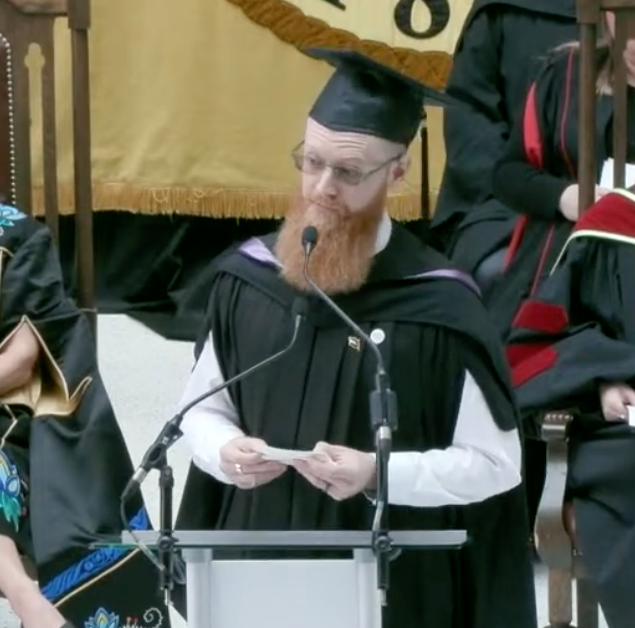Features
Antisemitism in the Medical Profession in Canada

By HENRY SREBRNIK (June 27, 2025) Antisemitism in Canada now flourishes even where few would expect to confront it. Since the Hamas attack on Israel on October 7, 2023, there has been a resurgence of antisemitism noticeable in the world of healthcare.
When Israeli Gill Kazevman applied to medical school, and circulated his CV to physician mentors, their most consistent feedback was, “Do not mention anything relating to Israel,” he told National Post journalist Sharon Kirkey in an Aug. 10, 2024, story. As a student at the University of Toronto’s Temerty Faculty of Medicine, “I began to see all kinds of caricatures against Jews. I saw faculty members, people in power, people that I’m supposed to rely on, post horrible things against Jews, against Israelis,” he added. The faculty created a Senior Advisor on Antisemitism, Dr. Ayelet Kuper, who in a report released in 2022, confirmed widespread anti-Jewish hatred.
The Jewish Medical Association of Ontario (JMAO) conducted a 2024 survey of 944 Jewish doctors and medical students from across Canada. Two thirds of respondents were “concerned that antisemitic bias from peers or educators will negatively affect their careers.” Dr. Lisa Salomon, JMAO’s president, reported that at the University of Toronto medical school only 11 Jewish students were completing their first year of medical school out of a class of 291. The medical school in 1974 saw 46 Jews in a class of 218.
Also in Toronto, Hillel Ontario called on Toronto Metropolitan University to investigate Dr. Maher El-Masri, who has served as the director of the Daphne Cockwell School of Nursing, because, the group contended, he has “repeatedly engaged with and spread extreme, antisemitic, and deeply polarizing content on his social media account.”
The National Post’s Ari Blaff in an article on June 12, 2025 quoted social media posts from an account Hillel claimed belongs to Dr. Maher El-Masri, who has been the director of the Daphne Cockwell School of Nursing. One message concerned a post about Noa Marciano, an Israeli intelligence soldier abducted by Hamas on Oct. 7, 2023, who later died in captivity. “This is what is so scary about people like her,” the TMU professor wrote. “They look so normal and innocent, but they hide monstrous killers in their sick, brainwashed minds.” Israel, he asserted a day after the Hillel notice, “is a baby killer state. It always has been.”
The Quebec Jewish Physicians Association (AMJQ) is fighting antisemitism in that province. Montreal cardiologist Dr. Lior Bibas, who also teaches at Université de Montréal, co-founded the group in the weeks following the October 7 terrorist attack. They feel young doctors have been bearing the brunt of anti-Israel sentiment since then. “We heard that trainees were having a hard time,” he told Joel Ceausu of the Canadian Jewish News Feb. 3. “We saw a worsening of the situation and were hearing stories of trainees removed from study groups, others put on the defensive about what’s happening,” and some saw relationships with residents deteriorating very quickly.
Dr. Bibas thinks there are similarities with Ontario counterparts. “Trainees are getting the brunt of all this. Their entire training ecosystem — relationships with peers and physicians — has changed.” Whether anti-Zionist remarks, blaming Jews for Israel’s actions, or other behaviour, it can be debilitating in a grueling academic and career setting. The fear of retaliation is so strong, that some students were unwilling to report incidents, even anonymously.
Jewish physicians have now founded a national umbrella group, the Canadian Federation of Jewish Medical Associations (CFJMA), linking the provinces, and representing over 2,000 Jewish physicians and medical learners, advocating for their interests and promoting culturally safe care for Jewish patients. And “it’s really been nonstop, given that we have a lot of issues,” Dr. Bibas told me in a conversation June 17. “People have been feeling that there’s been a weaponization of health care against Israel.”
He stressed that health care should remain politically neutral – meetings are an inappropriate venue in which to talk about the war in Gaza, he stated, and “this will just lead to arguments.” Nor should doctors, nurses and hospital staff wear pins with Palestinian maps or flags. And no Jewish patient being wheeled into an operating room should see this “symbol of hate.”
On Jan. 6, a group of Montreal-area medical professionals walked off the job to protest outside Radio-Canada offices, calling for an arms embargo, ceasefire and medical boycotts of Israel. Those who could not attend were encouraged to wear pins and keffiyehs to work. When asked if such a walkout should be sanctioned, Quebec Health Minister Christian Dubé’s office had no comment. Neither did the Collège des médecins (CDM) that governs professional responsibilities. The leadership of many institutions have remained passive.
B’nai Brith Canada recently exposed a group channel, hosted on the social media platform Discord, in which Quebec students engaged in antisemitic, racist, misogynistic and homophobic rhetoric. More than 1,400 applicants to Quebec medical schools, as well as currently enrolled medical school students, were in the group, which was ostensibly set up to support students preparing for admission to Quebec’s four medical programs. “I saw it, and it’s vile,” remarked Dr. Bibas, noting how brazenly some of the commentators expressed themselves, using Islamist rhetoric and Nazi-era imagery, such as referring to Anne Frank as “the rat in the attic.”
Doctors Against Racism and Antisemitism (DARA) said in a statement, “These messages are the direct result of the inaction and prolonged silence of medical school and university leaders across Canada since October 7, 2023, in the face of the meteoric rise of antisemitism in their institutions. Silence is no longer an option. Quebec’s medical schools and universities must act immediately. These candidates must not be admitted to medical school.” DARA member Dr. Philip Berger stated that “there’s been a free flow, really, an avalanche of anti-Israel propaganda, relentlessly sliding into Canadian medical faculties and on university campuses.”
In Winnipeg, a valedictory speech delivered to the 2024 class of medical school students graduating from the Max Rady College of Medicine at the University of Manitoba on May 16, 2024 set off a storm of controversy, as reported by Bernie Bellan in this newspaper. It involved a strongly worded criticism of Israel by Dr. Gem Newman. “I call on my fellow graduates to oppose injustice -and violence — individual and systemic” in Palestine, “where Israel’s deliberate targeting of hospitals and other civilian infrastructure has led to more than 35,000 deaths and widespread famine and disease.” The newspaper noted that “loud cheers erupted at that point from among the students.”
The next day, the dean of the college, Dr. Peter Nickerson, issued a strongly worded criticism of Dr. Newman’s remarks. On Monday, May 20, Ernest Rady, who made a donation of $30 million to the University of Manitoba in 2016, and whose father, Max Rady, now has his name on the school, sent an email in response to Dr. Newman’s remarks.
“I write to you today because I was both hurt and appalled by the remarks the valedictorian, Gem Newman, gave at last week’s Max Rady College of Medicine convocation, and I was extremely disappointed in the University’s inadequate response. Newman’s speech not only dishonored the memory of my father, but also disrespected and disparaged Jewish people as a whole, including the Jewish students who were in attendance at that convocation.”
In subsequent weeks Jewish physicians in Manitoba organized themselves into a new group, “The Jewish Physicians of Manitoba.” As Dr. Michael Boroditsky, who was then President of Doctors Manitoba, noted, “Jewish physicians in cities across Canada and the U.S. have been forming formal associations in response to heightened antisemitism following the Hamas massacre of October 7.”
After October 7, Jewish students at the University of Calgary’s Cumming School of Medicine reported exposure to repeated antisemitic posts by peers on social media, being subject to antisemitic presentations endorsed by faculty during mandatory classes, social exclusion and hateful targeting by university-funded student groups, and removal from learning environments or opportunities subsequent to antisemitic tirades made by faculty in public spaces.
In addition to online vitriol, medical students have been subject to antisemitic actions coordinated by university-funded student groups with physician-faculty support under the guise of advocating against the actions of the Israeli government. All instances of discrimination, they stated in a brief, have been witnessed by and/or reported to senior leadership of the medical school without incurring condemnation of the discrimination.
In Vancouver, social media posts vilifying Israel and espousing Jew hatred were circulated by physicians at the Faculty of Medicine of the University of British Columbia, noted an article in the National Post of May 25, 2025. Allegations included Christ-killing, organ trafficking, and other nefarious conspiracies supposedly hatched by Jewish doctors. Some asserted that Jewish faculty should not be allowed to adjudicate resident matching because the examining doctors were Jewish and might be racist.
In November of 2023, one-third of all UBC medical students signed a petition endorsing this call. Jewish learners who refused to sign were harassed by staff and students on social media. When challenged, the Dean of the medical faculty refused to recognize antisemitism as a problem at UBC or to meet with the representatives of almost 300 Jewish physicians who had signed a letter expressing concern about the tolerance of Jew hatred, and the danger of a toxic hyper-politicized academic environment. This led to the public resignation of Dr. Ted Rosenberg, a senior Jewish faculty member.
Here in the Maritimes, things seem less dire. I spoke to Dr. Ian Epstein, a faculty member in the Division of Digestive Care & Endoscopy at the Dalhousie University Faculty of Medicine. He helps coordinate a group supporting Jewish and Israeli faculty, residents and medical students.
“Our group is certainly aware of growing antisemitism. Many are hiding their Jewish identities. There have been instances resulting in Jewish and Israeli students being excluded and becoming isolated. It has been hard to have non-Jewish colleagues understand. That said our group has come together when needed, and we have not faced some of the same challenges as larger centres,” Dr. Epstein told me. Dalhousie has also taken a stand against academic boycotts of Israel, which some view as a form of antisemitism. The University of Prince Edward Island in Charlottetown has just opened a new medical school. Let’s hope this doesn’t happen here.
Lior Bibas in Montreal indicated that his group is worried “not only as Jewish doctors and professionals, but for Jewish patients who are more than ever concerned with who they’re meeting.” Can we really conceive of a future where you’re not sure if “the doctor will hate you now?”
Henry Srebrnik is a political science professor at the University of Prince Edward Island.
Features
Is This the End of Jewish Life in Western Countries?

By HENRY SREBRNIK “Globalize the Intifada” has been the chant echoing through streets since October 7th, 2023. It was never a metaphor, and we now see the gruesome results across the western world, from Australia to Canada: the rise of groups of large, active networks of Islamist and anti-Zionist organizations.
Jews in the West are discovering that the nations they defended, enriched, and profoundly shaped have become increasingly inhospitable. After the Holocaust, explicit Jew-hatred became unfashionable in polite society, but the impulse never disappeared. The workaround was simple: separate Zionism from Judaism in name, then recycle every old anti-Jewish trope and pin it on “the Zionists.”
We have seen the full legitimization of genocidal anti-Zionism and its enthusiastic adoption by large segments of the public. The protests themselves, as they began immediately on October 7th, were celebrations of the Hamas massacres. The encampments, the building occupations, the harassment campaigns against Jewish students, the open calls for intifada, the attacks on Jews and Jewish places have become our new norm. History shows us that antisemitism does not respond to reason, incentive or the honest appeals of the Jewish community.
Outside the United States, there is no Western political establishment with either the will or the capability to address this problem, let alone reverse its growth. I’m sorry to say this, but the future of Western Europe, Canada, Australia, and New Zealand is likely to be increasingly Jew-free.
Today, police stand and watch mobs chant for Israel’s destruction, call for the genocide of its people, harass visibly Jewish citizens, and drive antisemitic intimidation deep into urban life. They now believe their job is to enforce the law only if it does not risk upsetting violent constituencies. This makes Jews expendable, because defending them risks confrontation. This was very clear in the Bondi Beach massacre.
Jews are again donning caps instead of kippot, dressing generically with no cultural markers, and avoiding even a tote bag with Hebrew on it. A corrosive creep toward informal segregation in retail and service sectors is occurring, as Jewish customers report being refused service. A mezuzah hanging from a rideshare mirror leads to cancellations. When Jews express frustration, they are accused of exaggeration or attempting to suppress criticism of Israel. Jewish fear is not treated as a real problem.
“Jews Are Being Sent Back into Hiding,” the title of a Dec. 15 article in the New York Free Press by David Wolpe and Deborah Lipstadt, asserts that the attacks on Jews, including physical assaults, social media campaigns and, most tragically, the recent murders in Australia, are part of a purposive campaign designed to make Jews think twice about gathering with other Jews, entering a synagogue, going to kosher restaurants, putting a mezuzah on the doorpost of their apartments or dorm rooms, or wearing a Jewish star around their necks.
“We know of no one who would consider giving a niece, nephew, grandchild, or young friend a Jewish star without first asking permission of their parents,” they write. The unspoken, and sometimes spoken, question is: “Might wearing a star endanger your child’s well-being?”
Recently, a prominent American rabbi was entering a Target store in Chicago with her grandson, whom she had picked up from his Jewish day school. As they walked into the store the 10-year-old reached up and automatically took off his kippah and put it in his pocket. Seeing his grandmother’s quizzical look, he explained: “Mommy wants me to do that.”
Borrowing a phrase from another form of bigotry, they contend that Jews are going “back into the closet.” No public celebration of Hanukkah took place in 2025 without a significant police presence. Some people chose to stay home.
Lipstadt and Wolpe know whereof they speak. They are respectively a professor of history and Holocaust studies who served as the Biden administration’s ambassador tasked with combating antisemitism, the other a rabbi who travels to Jewish communities throughout the world, and who served on Harvard’s antisemitism task force in the aftermath of the October 7, 2023 pogrom.
What the world has seen over the past two years is a continual, often systematic attempt to terrorize Jews. When political leaders fail to condemn rather than merely “discourage” chants of “globalize the intifada,” we are seeding the ground for massacres like the Hannukah one in Sydney.
If each Jewish holiday will now be seen by antisemites as an opportunity for terror, then the prognosis for diaspora Jewry is bleak. There will be fewer public events, more alarms, more bag checks at doors; there will have to be more security and more police. Unless things change, Jewish life in the diaspora will become more sealed off from the larger society.
Why has this failure come about? Confronting antisemitism, stopping the mobs, challenging the activists, and disciplining antisemitic bureaucrats all carry electoral risk for politicians; Jews are demographically irrelevant, especially compared with Muslim voters, with the U.S. being the only partial exception.
There are those who suggest Jews stop donating funds to educational and other institutions that have turned against us. At this point, I doubt very much that withdrawing dollars will have an impact. For every dollar withdrawn, there will be 100 from Qatar and other sources in its place.
Throughout history, the way a society treats its Jews predicts its future with unerring accuracy. If Jews leave, it will be because a civilization that will not defend its Jews will also defend next to nothing and may itself not survive.
Henry Srebrnik is a professor of political science at the University of Prince Edward Island
Features
Canadian Travel Trends 2025 and the Forecast for 2026

Canadians planning to travel in 2026 should keep an eye on shifting trends and learn what’s coming their way in the new year.
Canadian travel has seen a fair amount of change and instability over the last few years, thanks mostly to the country’s southern neighbours. In 2025, and likely into 2026, travel trends in the Great White North have stabilized significantly, with more Canadians than ever choosing to travel within their own borders. And with 2026 nipping at our heels, let’s take a look at what trends in 2025 have been the most prevalent and how these will shape travellers’ decisions and travel plans in the new year.
Canadian Travel in 2025
Thanks to many factors, including politics, inflation, and airline competition, the majority of travellers opted to explore their own country rather than go abroad in 2025. More local travel money is remaining within the local economy, further bolstering it and making it an even more attractive travel choice. Thanks to the accessibility of private jet charter travel across Canada, luxury local travel has increased as well, with more people looking to immerse themselves in luxury from the start of their journey to the end. When travelling abroad, the U.S. is now the least favoured destination for most Canadian travellers, but Europe saw a significant increase in interest as 2025 progressed.
As local Canadian travel increased this year, it brought with it a drive for local tourists to find their own “Secret Canada” destinations. Far more “off the beaten path” trips were taken, resulting in more travel spending going to smaller or more boutique destinations rather than big city experiences. In 2025, travellers have sought out the wonderful diversity in destinations and landscapes, allowing themselves to access more grounded and authentically Canadian experiences.
Canada’s Government has also encouraged and benefited from local tourism, with initiatives like the Canada Strong Pass offering extra benefits. Initially implemented in the summer, but reintroduced from December 12, 2025, until January 15, 2026, this is a ticket to enjoying the richness of their own culture (iconic natural destinations, museums, train trips) at a discounted rate or even in some cases free of charge.

In the second quarter of 2025, locals took a total of 90.6 million trips that included at least some time spent travelling domestically, which indicated a rise of 10.9% on a year-over-year basis. Of these trips, 58.6 million were day trip experiences (an increase of 12.4%), and 32.0 million were overnight trips or longer (an increase of 8.4%).
Between April and June of this year, Canadian residents spent $20.3 billion on local tourism, which represented a 13.5% year-over-year increase. When undertaking day trips, Canadians spent approximately $101 per visit. On overnight trips, locals spent around $449 per trip, with an average trip length of 2.6 nights. The Great White North is clearly holding its own, and then some, in the international travel market.
Canadian Travel in 2026
As we move towards 2026, many trends from 2025 will remain the standard, but some will evolve to fit changing demands. Across the board, though, the outlook for the coming year is that Canadian travel will become a far more personal thing, with trips being customized to fit travellers’ requirements and desires more closely than ever before. From choosing a hotel that they feel smacks of a beloved destination in their favourite novel, to taking a trip to a destination just to try a snack that’s famously made there and only there, travel is stretching and shifting for the traveller rather than the other way around.
Here are some slightly more specific predictions for the coming year based on the answers of polled Canadians.

- One Gen Z-led trend is the idea of “glowmad travel”. Beauty and skincare are now influencing the places that Gen Z travels, and their trips are far more likely to include visits to skincare and beauty destinations like spas and luxury stores.
- Gen Z adults are helping to drive another trend: family travel as a way to save money. 345 of Gen Z adults polled say that they would take this route.
- More than 70% of Canadians are considering some sort of mountainous getaway in 2026, specifically in summer or autumn.
- 48% of polled Canadians say they would book or consider a destination thanks to the influence of literature.
- More travellers than ever are choosing their destinations based on the accommodations available. 44% of polled travellers say that in 2026, accommodation and what it can offer comes first, and the surrounding destination comes second.
The World Is Your Nova Scotia Lobster Roll
Choose something a little different when you vacation this year. Oysters are great, but a Nova Scotia lobster roll might be more to your taste! Canadians know good travel, so take a maple leaf out of their book and experience something new this year.
Features
Fake IDs and Underage Bettors: The Growing Problem for Sportsbooks
The expansion of legalized sports betting worldwide has resulted in sportsbooks grappling with a problem that they can no longer overlook: the increase in underage individuals using counterfeit identification to place bets. As more and more ways to bet through mobile apps and online sign-ups emerge, minors who are set on their goal are inventing ways to get around age limits. The emergence of this trend is a breach of the law and morality; however, it is also an enormous problem that threatens the very existence of the platforms, which are forced to rigorously obey the regulations .
Why Fake IDs Are Becoming More Sophisticated
Conventional fakes used to be quite simple to recognize—low-quality printing, different fonts for the text, and inconsistent holograms would make them not very reliable for any kind of verification. But counterfeit documents have changed significantly over time. Nowadays, fakes are made better with the help of printing technology and software, and they can even copy barcodes and other scannable features, so their IDs look almost real.
This fact complicates things significantly for sportsbooks, especially those operating online. Most of the time, automated identity verification systems capture a user’s photo and perform basic data matching. In cases where a very good fake ID is used by a teenager who looks older, some systems cannot recognize the trick. Therefore, young bettors have found ways to be able to place wagers through these loopholes.
The Influence of Social Pressure and Online Culture
Social media is a major factor in the increase in risky behavior that minors are engaging in. On various platforms such as Instagram, TikTok, and Reddit, teenagers come across betting slips, parlay wins, and big-payout screenshots that are shared, most probably, by other users. The glamorization of sports betting is leading young people to copy the behavior of influencers, older friends, or even celebrities, as they think that it is the right thing to do.
The competitiveness usually associated with sports is one of the reasons some minors decide to bet on sports. For many, betting becomes another way to engage as a fan—by predicting outcomes, challenging friends, and experiencing the same excitement that adult fans enjoy. Unfortunately, only a small number of minors fully understand the financial risks involved, making them more vulnerable to developing harmful patterns that could continue into adulthood. This is why choosing the most responsible sportsbook, which you can discover more here, is essential. Such platforms provide guidance, enforce safe practices, and ensure regulated play, allowing fans to engage with sports betting in a more informed, secure, and controlled manner.
Sportsbooks Facing Regulatory Pressure
The sportsbooks are being given the task of more closely monitoring and preventing minors from betting on their platforms. If they fail, harsh penalties are possible, including severe fines, loss of a gambling license, and negative publicity that undermines a brand’s trustworthiness. As a result, it is becoming increasingly difficult for people to verify their identities, although this also inconveniences those who are, in fact, legitimate users.
Sportsbooks have to decide between two options that are in conflict with each other: on the one hand, they have to keep the registration process as simple as possible, and on the other hand, they have to carry out age verification in a very thorough manner. The work of balancing is tough, and the underage gamblers are trying all methods to find a way out.
The Rise of Identity Fraud Services
An alarming trend is the emergence of online vendors who openly advertise fake IDs and identity documents. These vendors often claim their products can pass standard sportsbook checks. Some even tailor IDs to specific regions, knowing that certain provinces, states, or countries use verification systems that rely heavily on image comparison rather than live validation.
The availability of these fraudulent services not only empowers minors but also exposes sportsbooks to risks related to stolen identities, money laundering flags, and fraudulent accounts that may later become legal liabilities.
The Consequences for Underage Bettors
While a minor might think that gambling is just a bit of fun without any harm, the outcome can be quite serious. If there is a catching, accounts are closed right away, winnings are confiscated, and parents or guardians, in some cases, are made legally liable for any financial disagreements. Besides that, the risk of developing a gambling problem in the future increases with early exposure to gambling, especially since teenagers are more impulsive and less capable of handling financial risks.
The majority of minors are not aware that sportsbooks keep very detailed records of their activities, including device information and IP addresses. In case a fake ID works one time, using it multiple times will definitely lead to getting caught.
A Growing Problem That Requires Joint Action
Fake IDs and underage betting are issues that have become a major challenge in the industry, and no single stakeholder can solve these problems on their own. Sportsbooks need to enhance their identity verifications, regulators should get prepared for new types of fraud, technology providers have to come up with new solutions more quickly, and parents should always be aware of what their children are doing online. The industry’s rapid development is making this problem more and more urgent because the number of minors trying to get around the safety measures is increasing.
Sports betting can serve as a fun and legal form of entertainment for adults, but the need to protect the youth is what defines the industry and ensures its survival in the long run. As the quality of fake IDs keeps improving and the online culture is more and more inclined to consider betting as a normal activity, sportsbooks must ensure that underage users do not have access and that the environment is safe for all users. They need to do this now more than ever.

